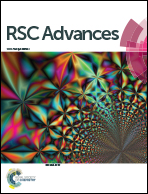Realizing semiconductor to metal transition in graphitic ZnO and MoS2 nanocomposite with external electric field†
Abstract
First-principles calculations have been used to investigate the structural and electronic properties of graphitic ZnO and MoS2 (g-ZnO/MoS2) nanocomposites. It is found that the binding strength of g-ZnO/MoS2 exhibits strong dependence of atomic arrangement of g-ZnO relative to MoS2. The coupling interaction of g-ZnO/MoS2 obviously reduces the semiconducting band gaps, compared to both individual sheets, which are sensitive to its stacking orders. Interestingly, the vertical external electric field (E-field) can be applied to enhance the stability of g-ZnO/MoS2 and increase charge transfers between these two component. Furthermore, the E-field with the positive direction from MoS2 to g-ZnO can tune the band gap of g-ZnO/MoS2 nanocomposites, whereas this nanocomposites produce the semiconducting to metallic behavior transitions when the E-field changes from positive to negative direction, regardless of the stacking pattern. The tunable electronic properties of g-ZnO/MoS2 nanocomposites under the E-field are attributed to the changes in electrostatic potential difference between atom layer of MoS2 and interlayer region close to g-ZnO. Present results suggest that the g-ZnO/MoS2 heterojunction provides promising applications for MoS2-based optoelectronic and nanoelectronic devices, such as fabricating field effect transistor (FET).


 Please wait while we load your content...
Please wait while we load your content...